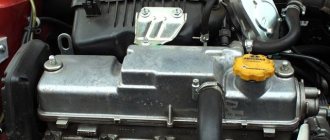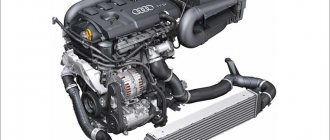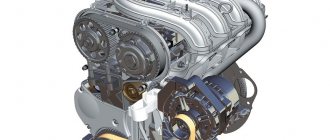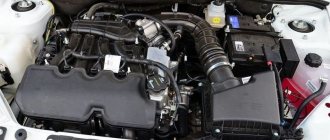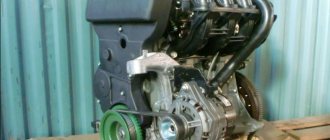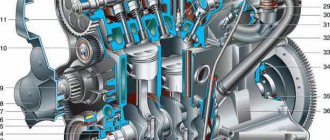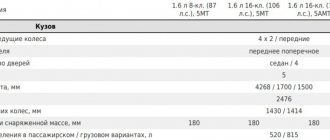Car : Lada Granta. Asks : Racer. Question : How much horsepower does the Lada Granta actually have?
When the Lada Granta began to be produced, the VAZ plant deliberately underestimated the power figures. According to the passport it is one thing, but in reality it is another. For example, instead of 87 horsepower, the engines in Norma develop 94. But someone says 98, and all measurements were carried out on a bench. At the same time, the engine itself is not twisted, the ECU is not changed, and everything works as if it came from the factory. Now, please, announce the entire list for each of the 5 engines. Or is it a secret?
| TOP 15 most useful products for Lada Granta - OUR EXPERIENCE! |
Lada Granta characteristics – Lada Granta technical characteristics
The characteristics of the Lada Grant are very similar to the characteristics of the Lada Kalina. This is no wonder Lada Granta was created on the basis of Kalina. Despite the fact that the characteristics of the dimensions of these cars are different, the distance from the front to rear wheels is exactly the same and amounts to 2476. That is, the Granta’s interior is the same in size as that of the Kalina . Although the interior decoration of Kalina and Granta is different. By the way, the characteristics of the Lada Grant in the hatchback body are already known. Let us remind you that this version of the domestic car will go on sale closer to the summer of 2014.
The increase in the size of the Granta was due to the increased size of the trunk; in addition, the designers increased the front part. The result is a rather cramped car, but with a fairly large trunk; you shouldn’t expect more from a 4-door budget sedan. The total length of the Lada Granta is 4260 millimeters .
Dimensions, dimensions and volumes of Lada Granta
- Length – 4,260 mm
- Width – 1,700 mm
- Height – 1,500 mm
- Base, distance between front and rear axle – 2,476 mm
- Front and rear wheel tracks – 1430 and 1414 mm, respectively
- Trunk volume – 520 liters
- Fuel tank size – 50 liters
The ground clearance of the Lada Granta with a manual transmission is 16 centimeters (160 mm), the ground clearance of the Lada Granta with an automatic transmission is 2 centimeters less and is 14 cm (140 millimeters). The manufacturer himself explains the lower ground clearance of a budget sedan with an automatic transmission by the fact that the weight of the engine in combination with the automatic transmission is greater.
The weight of the Lada Grant is 1,160 kilograms, with a full load of 1,560 kg. The manufacturer indicates that the car is capable of towing a trailer weighing 450 kilograms without its own braking system and 900 kg with a brake mechanism.
The characteristics of the Lada Granta transmission are as follows. The car has only front-wheel drive and two types of gearboxes: a manual 5-speed gearbox with a main gear ratio of 3.7. And an automatic transmission from the Japanese manufacturer Jatco with a gear ratio of 4.1. The 4-band automatic transmission of the Lada Granta makes the car much more comfortable, but you have to pay for everything, so fuel consumption with an automatic transmission is higher, and acceleration to the first hundred takes longer.
The characteristics of the Lada Granta engine are a very interesting topic for conversation. Let's say right away that Granta has a gasoline engine running on 95 gasoline and having one volume of 1.6 liters, or more precisely 1596 cubic centimeters. However, due to the fact that the design of this one engine is essentially different, the consumption, acceleration, and power indicators are completely different. Today, Grants are offered in 4 engine versions with 82, 87, 98 and 106 horsepower. Two engines have 8 valves, two more have a 16-valve mechanism. The four-stroke gasoline power unit has electronically controlled distributed injection with various settings. In general, the engine for Granta is of injection type. Modern injector, like on most foreign cars.
Interior
The interior of the Lada Granta is made quite simply, but as utilitarian and laconic as possible. It was clear that the designers worked collaboratively with the engineers and placed the instrument controls exactly where they needed to be. The owner will also be pleased with the large number of niches and shelves for storing small items that can be useful on the road. Despite the fact that the plastic is hard, it does not have any foreign smell even in new cars, it is made with high quality. Thanks to the optimization of the number of parts in the panels, it was possible to significantly reduce the noise of plastic in the car interior, which increases the comfort of being in it. For example, compared to the Lada Kalina, the number of parts in the door panels decreased from 18 to 3, in the dashboard from 48 to 18. The chairs have a dense filling, thanks to which the back gets less tired when sitting for a long time. Wear-resistant and non-staining upholstery will keep the interior clean and tidy for a long time. In extended versions, silver-painted elements will be added to the car interior: ventilation system deflector rings, center console surrounds, door handles.
Technical characteristics: LADA Granta sedan (Lada Granta)
| 1.6 l 8-cl. (87 hp) | 1.6 l 16-cl. (106 hp) | 1.6 l 16-cl. (98 hp) | ||
| BODY | ||||
| Wheel formula / drive wheels | 4x2 front | |||
| Engine location | anterior transverse | |||
| Body type / number of doors | sedan / 4 | |||
| Number of seats | 5 | |||
| Length / width / height, mm | 4268 / 1700 / 1500 | |||
| Base, mm | 2476 | |||
| Front/rear wheel track, mm | 1430 / 1414 | |||
| Ground clearance under the power unit (fully loaded), mm | 180 | 165 | ||
| Luggage compartment volume in passenger/cargo versions, l | 520 / 815 | |||
| Engine | ||||
| Engine code | 11186 | 21127 | 21126 | |
| engine's type | petrol | |||
| Supply system | electronically controlled fuel injection | |||
| Number, arrangement of cylinders | 4, in-line | |||
| Working volume, cubic meters cm | 1596 | |||
| Maximum power, kW (hp) / rev. min. | 64 (87) / 5100 | 78 (106) / 5800 | 72 (98) / 5600 | |
| Maximum torque, Nm / rev. min. | 140 / 3800 | 148 / 4200 | 145 / 4000 | |
| Recommended fuel | gasoline 95 | |||
| Dynamic characteristics | ||||
| Maximum speed, km/h | 172 | 184 | 176 | |
| Acceleration time 0-100 km/h, s | 11,6 | 10,5 | 12,0 | 13,1 |
| Fuel consumption | ||||
| Urban cycle, l/100 km | 9,1 | 8,7 | 9,9 | |
| Extra-urban cycle, l/100 km | 5,3 | 5,2 | 6,1 | |
| Combined cycle, l/100 km | 6,8 | 6,5 | 7,2 | |
| Weight | ||||
| Curb weight, kg | 1075. 1160 | |||
| Technically permissible maximum weight, kg | 1560 | |||
| Maximum trailer weight without brake system / with brake system, kg | 450 / 900 | |||
| Fuel tank volume, l | 50 | |||
| Transmission | ||||
| Transmission type | 5MT | 5MT | 5AMT | 4AT |
| Final drive ratio | 3,9 | 4,1 | ||
| Suspension | ||||
| Front | independent, MacPherson type, spring, with gas-filled telescopic shock absorbers, with anti-roll bar | |||
| Rear | semi-independent, lever, spring, with gas-filled telescopic shock absorbers | |||
| Steering | ||||
| Steering gear | rack and pinion | |||
| Tires | ||||
| Dimension | 175/65 R14 (82, H); 185/60 R14 (82, N); 185/55 R15 (82, H/V) | |||
Body Specifications
Lada Granta technical characteristics of the body: is a four-door sedan with a front transverse engine. The driving wheels are the front pair of wheels, the wheel formula is 4 x 2. The length of the car is 4260 mm, width 1700 mm, height 1500 mm. The ground clearance is respectively 160 mm. I would especially like to dwell on the volume of the trunk (it is very impressive), which holds 520 liters. The base size is 2476 millimeters.
What changed?
By “lucky coincidence,” the author was the owner of a Granta (a 2017 liftback, in the minimum Norma configuration) and came to the test armed for comparisons.
In 2022, VAZ carried out a restyling, designing the front in the “X-style”. The main pair in the transmission was changed from 3.7 to 3.9. All engines were made “non-plug-in” - if the timing belt breaks, the pistons do not meet the valves. Engine control program calibrations have been adjusted. For example, the eight-valve engine now picks up more confidently after the first outbreaks during a cold start. The temperature regime has also changed. If during the cold season you see that the operating temperature after warming up has frozen around 80–82 degrees, do not be alarmed. The thermostat in this case is working properly.
The new dashboard is beautiful and easy to use. But it’s much more “talkative” than the simple old one - with a minimum number of parts, caps and designer inserts.
The new dashboard is beautiful and easy to use. But it’s much more “talkative” than the simple old one - with a minimum number of parts, caps and designer inserts.
The 1.6 (98 hp), 4AT Luxe (from RUB 660,800) package includes an audio system and four speakers. | In version 1.6 (87 hp), 5MT Classic (from RUB 506,500) there is only audio preparation. You will have to purchase and install the radio at your own expense. In version 1.6 (87 hp), 5MT Classic (from RUB 506,500) there is only audio preparation. You will have to purchase and install the radio at your own expense. |
If you take a car without a radio, only with audio preparation, keep in mind that the speaker wiring to the doors is laid normally, and the antenna cable is a pure formality. It runs from the roof antenna to the bottom of the right A-pillar trim. Without an extension cable, you won't be able to reach the audio center.
Salon Lada Granta Sport 2020
The interior decoration of the car will not greatly please you with its quality, but it will please you with a considerable amount of free space. The driver and front passenger will sit in good seats with mechanical adjustments, slight lateral support and red stitching. The back row is designed for three passengers, and they will be able to fit there, but it will be much more comfortable for only two passengers.
The driver will have in his hands a 3-spoke leather steering wheel with red stitching, which is mechanically adjustable only in height. The instrument panel is ordinary, but at the same time clear and informative. It has a large speedometer and tachometer and a non-color trip computer in between. To the left of the steering wheel there are selectors for turning on and adjusting the lights, and there is also a button for opening the trunk.
The center console is equipped with air deflectors in the upper part, made in the style of Renault Logan. Nearby there is an alarm button, and below it there is a 7-inch display of a multimedia system with a navigation function. A little lower there is a control unit for the heater and air conditioner; the selectors are made in the form of the usual knobs.
Liftback, sedan, hatchback or station wagon - which body should you choose?
Four body types for a budget car - an enviable variety. The wheelbase is the same for all, but then the demand for one or another modification largely depends on the rear overhang. That is, the size of the floor, and therefore the volume of the trunk in the standard configuration - with the rear seats not folded and the shelf in the headrest area not removed. The hatchback has a trunk of 240 liters, the station wagon - 360. Unfortunately, there is no “barn” with a large overhang, and in terms of cargo compartment capacity it is easily surpassed by the sedan and liftback with indicators of 500 and 440 liters. In this pairing, the sedan is a mathematical winner, but, say, the trunk lid stops still eat up some of the usable space.
In terms of ease of loading/unloading and the ability to accommodate large luggage, the victory goes to the liftback. Its fifth door rises up along with the rear window and opens a huge opening. It easily fits items that cannot be squeezed into a sedan.
The Granta liftback also has two hooks in the niches of the cargo compartment on which you can hang bags of goods from the supermarket. Very convenient - they don’t crawl on the trunk floor while driving. Needless to say, within the Grant family, a couple of sedan-liftbacks are in great demand.
Options affecting the characteristics of the Lada Granta car
Speaking about the technical characteristics of the Lada Granta, I would like to talk separately about the existing option packages that the car plant offers for each model variant. There is truly room for activity. From the most minimal to the most luxurious, including climate control, parking sensors with a rear view camera, and a multimedia system with an on-board computer.
A special feature of AVTOVAZ is that by choosing the appropriate package of options, you don’t have to think about tuning the car, since everything will be done at the factory. Each option is assigned its own digital identification, which can be quite difficult to understand. For example, the technical characteristics of the Lada Granta 219010 differ from the technical characteristics of the Lada Granta 219060 only in that one has the “Standard” equipment, and the other the “Norma”. If you decide to buy this car, the auto shop specialists will help you figure it out.
I would like to dwell on one more, quite interesting, point regarding the technical characteristics of the VAZ Grant. Many smart people and “experts”, when assessing this car, constantly compare it with the leading models of the Western automobile industry. And its dynamics are sluggish, and its design is backward, and the plastic in the interior is cheap. But Toyota (Mercedes, BMW, etc.) is a completely different matter. Don't pay any attention to them!
For the first time in Russia we have a car that comes close to leading world positions. And there is nothing to say about the price-quality ratio. Our consumer wants to buy inexpensively, but the quality and design are at their best. And according to its technical characteristics, the Lada Granta car is an ideal option. You can choose from the cheapest to the most expensive option package.
So, those who want to buy an inexpensive car with the most affordable equipment should study the technical characteristics of the VAZ 219110 or the technical characteristics of the Lada Granta 219060, and for those who have more options, it makes sense to take a closer look at the VAZ 21902-42-11 or VAZ 219170 whose technical characteristics more expanded.
We must not forget that our VAZ 2190 with basic technical characteristics has already received international recognition. In 2014, at the height of summer in Argentina, a grandiose car show was held, at which Russia was represented by the Lada Granta 219010.
Not only did our car not get lost among the world's leading models, it also entered the top ten! Many of the world's leading racing drivers have driven a Lada Granta car and confidently recognized the technical characteristics of the Lada Granta 219010 as meeting all modern requirements.
It's no secret that in the near future, VAZ plans to start producing a crossover under the so far tentative name X-Ray. And in this regard, the development of the Lada Grant received an unexpected continuation - the appearance and design of the new car turned out to be so successful that it was decided to update the Grant in the same style.
Now we can safely say that the technical characteristics of the 2016 Lada Grant will be significantly improved. In any case, the car will receive an updated appearance and become more modern.
Which engine and which gearbox is better?
Eight-valve VAZ-11186 engine with a power of 87 hp. It is aggregated only with a five-speed manual transmission. An excellent pair for Russian operating conditions! Simple, reliable, maintainable. Let's call it the most universal and family-friendly.
The updated Grants with this power unit have become a little more high-torque. When driving under tension there is less detonation clanging. Fuel consumption has increased within reason. From the pre-restyling liftback it was possible to squeeze out 4.9–5.2 liters per 100 km on an empty country road. The current car in similar conditions “eats” 5.5–5.6 liters per hundred. But more realistic values are still 5.8–5.9 in summer and 6.0–6.2 in winter. The short main pair and the updated engine control program had an effect.
The option is more likely for youth - a sixteen-valve VAZ-21127 engine with a power of 106 hp. with the same five-speed manual transmission. The faster it is, the more expensive it is. But on cars of lower trim levels the price tag is even more or less acceptable. But the same engine with a robotic gearbox cannot be called a great success. Although a robot is cheaper, it cannot replace a full-fledged automatic in terms of ease of control, comfort during switching and reliability (we are talking about clutch life). Especially in a metropolis.
A suitable habitat for a robot is provincial cities that are not overloaded with traffic jams. And if there is an ardent desire to take a Grant with two pedals, and even with an eye to operation in a large city, it is better to take a closer look at the deformed sixteen-valve VAZ-21126 with a power of 98 hp. with a four-speed Jatco automatic transmission. True, the price tag of such a “stuffed” Grant is comparable to the price of Vesta and Logan of lower trim levels.
The lion's share of sales comes from Grants with an eight-valve engine, and therefore a manual transmission. Variations with automatic transmissions are, in fact, just exotic to expand the range.
The lion's share of sales comes from Grants with an eight-valve engine, and therefore a manual transmission. Variations with automatic transmissions are, in fact, just exotic to expand the range.
This is interesting: Where is the body number on Renault Duster
Expert answer
To the question asked here, no one can answer “Yes, you are right” or “No, you are wrong.”
The power of each engine is a unique indicator.
It differs from one specimen to another, and sometimes very strongly. Maybe someone even measured 98 “forces”, but the measurement error could not be less than 2-2.5 percent. On one stand you will get 98, on another – 95.5, and then another 100.5 “forces”! Draw conclusions.
Engine power increases as the engine is fully run-in, and decreases as it wears out.
- 11183 – 82 hp at 5200 rpm;
- 11186 – 87 hp at 5100 rpm;
- 21116 – 87 hp at 5100 rpm;
- 21126 (16 V) – 98 hp at 5600 rpm;
- 21127 (16 V) – 106 hp. at 5800 rpm.
The engine model used in each specific car depends on the configuration. Today there are three main configurations: “Standard”, “Norma” and “Lux”.
How much horsepower does the Lada Granta actually have?
Car : Lada Granta. Asks : Racer. Question : How much horsepower does the Lada Granta actually have?
When the Lada Granta began to be produced, the VAZ plant deliberately underestimated the power figures. According to the passport it is one thing, but in reality it is another. For example, instead of 87 horsepower, the engines in Norma develop 94. But someone says 98, and all measurements were carried out on a bench. At the same time, the engine itself is not twisted, the ECU is not changed, and everything works as if it came from the factory. Now, please, announce the entire list for each of the 5 engines. Or is it a secret?
Technical characteristics of gearbox and automatic transmission
Our auto industry does not produce automatic transmissions, apparently the level of production does not yet allow this. Therefore, the Lada Granta is equipped with a Japanese unit purchased abroad. It was no coincidence that one of the Nissan factories was chosen, specializing in the production of automatic transmissions, one of the models of which (though ten years ago) ideally suited the Lada Granta transmission. The car turned out to be a sight to behold - smooth ride, no jerks, improved acceleration dynamics, ease of control.
Drivers forced to spend long periods of time stuck in city traffic jams seem to fully appreciate the convenience of an automatic transmission. But even here the economic crisis did not pass by - due to the rise in exchange rates, the production of cars with automatic transmissions temporarily ceased.
Equipment Lada Granta Sport
- The basic equipment of Grant Sport includes the following options: Special reinforced sports suspension Special sports manual transmission Special enlarged brake discs Disc brakes on the rear wheels Two front airbags Seat belt pretensioner for the front seats Hydraulic headlight corrector Fog lights Anti-theft alarm with remote control Braking systems ABS and BAS Special sports-style front seats Sports steering wheel trim Sports gearshift trim Electric power steering Cabin filter On-board computer built into the instrument cluster Central locking with remote control Heated front seats Electric lifts for all doors Climate system Multimedia system Special aerodynamic body kit 16-inch alloy wheels
This will probably not be enough for some and the improvements and tuning of the Lada Granta Sport will flourish wildly. Surely manufacturers of large spoilers and crazy body kits are already riveting crafts in their garages. And motorists are thinking about how to adapt the turbine to the standard Lada Granta Sport 1.6 engine in order to surprise with its agility at traffic lights.
Summary of technical characteristics
Let us finally try to emphasize those technical characteristics of the Lada Granta car, those distinctive features that make it truly popular.
Firstly: it is a modern, expensive appearance, the rapid contours of which directly speak of its character.
Secondly: a spacious and comfortable interior, easy and thoughtful controls.
Thirdly: a powerful engine and energy-intensive suspension, an improved sound insulation package. Fourth: multimedia system with touch control and daytime running lights.
Fifth: front passenger and driver airbags, automatic transmission.
The combination with an inexpensive price and inexpensive maintenance allows the Lada Grant to claim the well-deserved title of “people's” car. It’s not without reason that even now the entire automotive community calls the Lada Granta the “business card” of the Volzhsky Automobile Plant.
Add a comment Cancel reply
At the autumn auto show in Moscow 2012, AvtoVAZ, as promised, presented a civilian version of the Lada Granta Sport sedan (photo, price), which received an aerodynamic body kit, a retuned suspension, stronger brakes and a forced engine.
The car was developed jointly with a subsidiary of Lada Motor Sport Technologies and differs externally from the regular Granta by an aerodynamic body kit with different bumpers, door sills, a spoiler on the trunk lid and 16-inch alloy wheels.
Options and prices of Lada Granta Sport 2019
| Equipment | Price |
| 1.6 (106 hp) Drive Active MT5 | 554 900 |
| 1.6 (114 hp) Sport MT5 | 633 900 |
MT5 - 5-speed mechanics.
Under the hood of the Lada Granta Sport 2017-2018 (specifications) there is a 1.6-liter naturally aspirated gasoline engine producing 114 horsepower and a maximum torque of 160 Nm, which is transmitted to the front axle wheels through an upgraded five-speed manual gearbox.
The car accelerates from 0 to 100 km/h in 9.5 seconds, and the maximum speed of the model reaches 198 km/h. To match the increased potential, engineers lowered the sedan's suspension and made it stiffer. All-round disc brakes are installed.
The overall length of the car is 4,280 mm, width - 1,700, height - 1,470, ground clearance (clearance) is stated at 150 mm, curb weight - 1,140 kg. The trunk volume is 520 liters, and the fuel tank is designed for 50 liters.
The interior of the civilian version of the Grant Sport includes sports seats, a leather steering wheel and gearbox cover, as well as metal pedals. Small-scale production of the car started on February 27, 2013, and today the price of the car is 633,900 rubles.
Later, a more modestly equipped version of Drive Active appeared for 554,900 rubles. with a 106-horsepower engine. This option makes a hundred from a standstill in 10.8 seconds, and the maximum speed is 179 kilometers per hour. Average fuel consumption in the combined cycle is stated to be 6.7 l/100 km (in the city 8.6, on the highway - 5.6). The more powerful version consumes 7.8 liters (6.8 on the highway, 10.1 in city mode).
Only 50 selected dealers are engaged in selling the new product, in the showrooms of each of which, especially for Granta Sport, a separate zone is equipped. They had their first “live” cars for introduction and test drives in April 2013, and sales started in the second quarter. In total, about a thousand cars were assembled in the first year, and 25 companies were included in the list of selected dealers.
Lada Granta Sport is an interesting phenomenon in the line of modern domestic passenger cars. A sedan in this body has been produced since 2012, and during this time it has gained many fans. Outwardly, it looks more attractive and interesting than the classic version. There are no boring and outdated details that were inherent in AvtoVAZ models of previous generations in the Lada Granta Sport
none left - this is a fast, stylish sedan that inevitably attracts attention.
Engine characteristics Grants
The VAZ 11183 engine was first used for installation on the Lada Kalina. This is a four-cylinder device with 8 valves and a volume of 1.6 liters. Structurally, this power unit is almost no different from the 21114 engine, widely used by the manufacturer on its models, starting with the VAZ-2109 and ending with modifications of the Kalina.
According to experts, both 11183 and 21114 have the same parameters and characteristics of all parts of the engine: block, camshaft, head, valves, crank mechanism, etc. That is, in fact, these are the same engine with different names .
11183 is characterized by increased environmental friendliness, reliability and increased volume. The timing drive is a belt drive, located in such a way that a broken belt does not bend the valves. This is also facilitated by deep piston recesses.
According to the plant, the service life of 21114 does not exceed 150 thousand km, but in practice the engine has successfully covered a mileage of 200 thousand. The service life of 11183 officially has an indicator of 200 thousand km.
The modernization of the engine was carried out by engineers from the Volzhsky enterprise. They managed to achieve a reduction in the specific consumption of fuels and lubricants, while the minimum engine resource increased to 200 thousand km.
The new Lada Granta liftback car is equipped with 3 types of engines: 11186, 21126 and 21127. The VAZ 21126 with 16 valves and 2 camshafts is considered the main engine of the car. The technical characteristics of such an engine allow it to develop power up to 98 hp. and be combined with an automatic transmission. But in comparison with 21116, the 21126 engine has higher gasoline consumption and worse dynamic performance.
An even more advanced power unit 21127 allows you to achieve a power of 108 hp. At the same time, fuel consumption per 100 km range is reduced by almost 1 liter. The technical characteristics were improved by introducing into the mechanism of the intake manifold of the engine a part that performs passive supercharging.
Lada Granta with 8-valve engine
Eight-valve engines are considered basic and are presented in two units. Separately, it should be noted that if the timing belt breaks, the valves will not be bent only in one engine - 11183-50, which, by the way, is considered the weakest. Therefore, no matter what happens, the timing belt must be replaced in a timely manner.
- Engine 11183-50.
This, as mentioned earlier, is the weakest engine of all that is presented in the Grant line. Its power is 82 horsepower. By the way, this engine is considered a more simplified version of what is installed on the VAZ-2111.
But there are also characteristics in which this engine differs from the original. Namely:
- improved environmental performance;
- increased reliability parameters;
- reduced "crankiness".
In addition, the above engine also has such features as high-torque power and elasticity, which is especially important when driving off-road.
The disadvantages of this type of engine are considered to be:
- the need to periodically adjust the valves;
- increased noise when the engine is running.
Benefits include:
- cast iron used as the basis of the cylinder block;
- maximum torque – 125 Nm, which is achieved already at 3 thousand revolutions;
- The compression ratio cannot be higher than 9.6.
- Engine 11186.
This motor is a slightly improved modification of the motor installed on the VAZ-21114.
Regardless of the fact that this engine has an undeniable advantage in the form of 87 horsepower, it also has a significant drawback. The fact is that, compared to the engine we discussed above, this one has a much shorter lifespan, and if the timing belt breaks, the car itself will need to be repaired, since the valves will be bent.
Advantages:
- increased compression ratio (10.5);
- torque - 140 Nm at 3.8 thousand revolutions;
- economical fuel consumption, both during urban driving and on the highway.
- Engine 21116.
This type of engine is completely identical to 11186. The only difference between them lies in the piston system, since it has a French-made piston installed on it.
Updates and shortcomings
The table clearly shows how many horses the Priora had with the old power plant and how the power and torque changed as the update progressed. Here is a description of how the design features of the new units changed compared to the old ones:
- The number of valves has increased, there are 4 of them for each cylinder. It's no secret what a positive impact this factor has on engine performance. The filling of the cylinder with the combustible mixture improves, the chamber is qualitatively emptied of combustion products (exhaust gases), the operation of the unit becomes more stable, power increases while fuel consumption decreases.
- The compression ratio is increased by increasing the piston stroke. The new engine 21126 and 21127 now uses gasoline with a higher octane number, but at the same time the efficiency of fuel combustion increases, which has a positive effect on power. It’s impossible not to notice how the working volume of the Priora’s engine has increased thanks to the increased piston stroke.
- In modification 21127, compared to 21126, the intake manifold was modified. How this affected the engine performance of the Priora can be seen in the table. Power increased by 8 hp. in addition, performance at low and medium speeds has improved.
- The new engines on the Priora have better environmental performance and lower fuel consumption. This was achieved through such improvements as modernizing the crankcase ventilation system and reducing the weight of the piston group. Now crankcase gases are burned more intensively in the cylinders and the emission of harmful substances into the atmosphere has decreased.
- Over the many years of operation of VAZ vehicles, a definite opinion has developed that the power units of Zhiguli cars do not last 150 thousand km until they are overhauled. Now, due to the use of new, higher quality components, the engine life has increased to at least 200 thousand km.
Despite the fact that the updated Priora engine is almost the most advanced domestic unit, it has its drawbacks. For example, when a timing belt breaks, the valves inevitably collide with the pistons and bend - this is its most serious drawback. How to eliminate it without waiting for trouble? It is necessary to replace the standard pistons with new ones, with special selections for the valves.
The remaining shortcomings are not so significant and they are usually associated with some kind of defect that can still be found on domestic cars. This could be increased noise from the operation of hydraulic compensators (often found on VAZ cars), an unexpectedly burnt gasket under the cylinder head, or floating idle speed. Or some unit of the attached equipment fails:
- a drop in fuel pressure in the system leads to difficulty starting the Priora engine and loss of its power;
- sensor malfunctions;
- air leaks in the fuel tract through the pipes;
- problems with the injector throttle valve.
How does it go and, most importantly, where?
Grant is not a champion on the race track. It does not shine with refined handling on the “parquet” floor. Here it is reliable in taxiing, but no more. But in Russia there are few truly smooth roads. To understand Granta's abilities, we need to shift the coordinate system. How to compare a car with a ground clearance of 195 mm in running order and 160 mm when fully loaded? Yes, with a single-wheel drive crossover!
The Granta has an almost impenetrable suspension, excellent ride quality on crushing and undulating surfaces, excellent cross-country ability for a single-wheel drive and very good handling for such a tall passenger car, and even with high-profile tires.
LADA News
We draw your attention to the fact that all information presented on the site is for informational purposes only and under no circumstances constitutes a public offer as defined by the provisions of Article 437 (2) of the Civil Code of the Russian Federation. By providing your personal data and using this website, you consent to the processing of your personal data and accept the terms of their processing
Privacy Policy
By providing your personal data and using this website, you consent to the processing of your personal data and accept the terms of their processing. Privacy Policy
To improve the convenience of using the site and ensure its correct operation, AutoHERMES uses cookies. These files contain data about your previous visits to the site. Cookies do not identify your personal data. All information is strictly confidential. If necessary, you can disable cookies using your browser settings.
Is it comfortable to sit?
The front seats are a compromise. Relatively high rise, not very long cushion, but overall decent back support. However, after restyling, the chairs became more pleasing to the eye, but less pleasing to the back and legs. The old-style padding was a little more comfortable - on a long journey the desire to stretch did not come as often. And of course, restyling did not correct the main drawback of the rear of the Granta - the narrow space in the area of the lower part of the doorways. But this inconvenience of getting on/off is an inevitable price to pay for stamping the floor under a large fifty-liter tank.
8 valve engine
On the Lada Granta, the car owner will find engines with 8 valves and 16 valves. They differ from each other in technical characteristics and displacement. Car owners don't like early engines because they are noisy. Some engines with 16 valves often suffer from broken belts and bent valves, which negatively affects owner reviews. But in general, these engines are reliable and last up to 250 thousand kilometers without major repairs.
Let's see what engines were installed on the Lada Granta from 8 valves:
- VAZ 1183-50;
- VAZ 21116;
- VAZ 11183.
Now let’s look at the technical characteristics of the first two engines, which represent improved versions of the primitive VAZ 11183 engine.
Engine Specifications
You will see the technical parameters of eight-valve engines in the table below.
| Characteristics 1183-50 | Meaning |
| Cylinders | 4 |
| Type | Row |
| Volume | 1.6 l |
| Valves | 8 |
| Compression | 10 |
| Power | 82 horses |
| Weight | 112 kg |
The fuel consumption of the Lada Granta engine in mixed mode is 7.4 liters. The engine torque is 132 Nm.
This is the simplest engine that is installed on Lada Granta cars: sedan or hatchback. The engine valves are not afraid of belt breakage. Unlike the primitive engine from which this power unit was created, the 1183-50 is distinguished by low-speed torque and environmental friendliness. The manufacturer assigns it the Euro 4 environmental class.
The negative aspects of the engine, according to reviews from car owners, include noise and constant adjustment of thermal valve clearances after a run of 15 thousand kilometers. If the thermostat breaks down, the engine stops heating to the required temperature.
Engine problems include burnt gaskets or valves. Because of this, the motor may operate unstably.
Despite some disadvantages, for those car owners who want to have a small and unpretentious engine, which also consumes little, this 1183-50 is an ideal solution for installation in a Lada Granta car.
Now let's look at the technical characteristics of another eight-valve engine.
| Value 11186 | Parameter |
| Type | Row |
| Cylinders | 4 |
| Volume in liters | 1,6 |
| Cylinder diameter | 82 mm |
| Piston stroke | 75,6 |
| valves | 8 |
| Torque | 143 |
| Power | 87 hp |
| Fuel supply | Injection method |
| Fuel used | Gasoline AI 95 |
This engine is an improved power unit of the VAZ 21114 model. Among the advantages, one can observe a decrease in engine noise and fuel savings.
The downside is that the pistons are lighter. Because of this, there is no room for recesses in such pistons. Therefore, when the belt breaks, the valves bend.
Device
Both engines have a cast iron cylinder block. The BC head is made of aluminum alloy. What sets them apart from other engines is their unreliable electronics, which can freeze on a frosty day or rainy weather in the summer. And the use of low-quality fuel will certainly lead to burnout of the valves.
The engine design itself looks quite reliable. Eight-valve power units last a long time with annual maintenance and prevent belt breakage.
Engine life
Lada Granta engines run up to 250 thousand kilometers without major repairs. Engine maintenance consists of replacing filter elements every 15 thousand kilometers. The air filter can be changed after 27 thousand km.
Filling and updating of lubricant is done after a run of five or 10 thousand kilometers. Depends on the region where the machine is used. But the coolant can be replaced after 60 thousand kilometers.
What if you service the car yourself?
The plant's obligations are a useful thing. But to maintain the warranty, you must undergo regular maintenance from authorized dealers. The amounts from the first to the fifth maintenance are as follows: 1900, 7700, 7300, 7700, 10,000 rubles. This is for five years or 60,000 km. There seem to be no super complex manipulations, the price of consumables is cheap, but still expensive. The machine is generally reliable. Hmm!
I won’t advise, but I’ll give you a calculation for those who want to spit on the guarantee. With self-service, 2,500 rubles for maintenance costs you a fair amount. This will include the price of work at a garage service, good domestic oil, and branded consumables from Lada Detail. Yes, in general, and valve adjustment for 87-horsepower engines. Moreover, many online stores offer ready-made sets of consumables for specific maintenance. Which is convenient and cheap.
In general, there is an opportunity to save twenty thousand or even more for five maintenance. For the people, Grants are a good insurance fund in case of a sudden breakdown. Enough for suspension struts, replacing a windshield, a tire that cannot be repaired, and eliminating a number of other troubles.
Price of Lada Granta 2190 on the secondary market
Official dealers estimate such a sedan new in the range from 440 to 630 thousand rubles.
On the secondary market, prices start from 100,000 and reach 500,000 rubles for a car with low mileage.
You can contact the site administrator by email: [email protected]
All texts were written by me, are authored by Google, included in the original Yandex texts and notarized. For any borrowing, we immediately write an official letter on company letterhead in support of search networks, your hosting and domain registrar.
Next we go to court. Don’t try your luck, we have more than thirty successful Internet projects and have already won a dozen lawsuits.
The site contains: 309,561 cars
Got in and drove off or what?
There are things that I recommend doing right away. It is advisable to check the wheel alignment without delaying
. I had no questions about the pre-restyling car - I drove it without problems with the wheels up to 50,000 km. But the updated liftback and similar Grants from friends were slightly eating away at the outer part of the tread on the front tires. Exactly so much that it can be attributed to the imperfect quality of cheap tires. Indeed, the steering wheel is straight, the car does not pull anywhere while driving, the run-out is good, and fuel consumption is low. But I stopped by to check so as not to guess on the coffee grounds. The officials announced about five thousand rubles for the operation! Result: caster and camber are normal. Moreover, the parameters for the left and right wheels have very minimal discrepancies. The problem was with the toe-in - a slight fall out of the tolerance range. Simply put, the wheels were spinning a little. The shoes have been rehabilitated. I understand that two new 14-inch Artmotion tires from Belarus will cost less than checking wheel alignment angles from the officials. But there is also a winter set.
I’ll mention a couple of very useful and inexpensive modifications that are best done in the first days of operation. The first is a self-adhesive seal for the gap between the upper edge of the windshield and the roof
(pictured above).
In this area, the paint is highly susceptible to abrasive wear. The second is cheap plastic tubes for upgrading the seals of the sliding windows
. Grant has one drawback - the slightly open windows rattle unpleasantly in the openings. The tubes are pushed into the seal and the itching disappears. The modification does not interfere with the operation of the power window.
Features, malfunctions and repair of the Lada Granta Sport engine
The basis for the creation of the first serial sports engine was the 21126 Priora engine, with a lightweight ShPG and, very importantly, with wider shafts. This engine was equipped with TMS lift camshafts 9.55/9.15, phase 288/282, modified intake, exhaust with a spider, and of course its own firmware. All this added up to a smooth engine, running from the bottom without problems and developing about 120 hp. See the measurement schedule below.
By nature, the engine up to 3000 rpm drives like a regular 126 engine, then it’s faster until the cutoff. Fuel consumption on the Grant Sport has remained virtually unchanged (with quiet operation). Otherwise, this is a Priora engine with all its shortcomings and features, the malfunctions and their causes coincide one to one, we read about them in the section “Faults 21126“.
What about sound insulation?
When measuring the noise, I didn’t expect any revelations from Granta. But in vain! Already at idle, it easily outperformed the Datsun on-DO and Renault Logan that took part in the “Behind the Wheel” test. I tried it on several times. I deliberately stood closer to the traffic lights, where the flow of traffic starts, truck engines growl, and semi-trailers clank. In vain: a short burst on the device, and then averaged readings around 42 dB.
Let's get going. Fourth gear, flat road, speed 50 km/h. Granta and I again easily “wash” a couple with an automatic and a CVT. Lada produces 61.5 dB versus 66 for on-DO and 64 for Logan. Moreover, Granta is on itchy studded tires, and this is the loudest measurement of several.
Well, you give a hundred in fifth gear! And again a victory: 61.9 dB versus 73 and 68.8. So far, in our tests, only Vesta is quieter. Idling unconditionally. In operating modes too, but on summer tires the gap over the Granta should be reduced.
And now the fly in the ointment. The Granta is averagely quiet on smooth roads. But after changing gears, the hum of gearbox gears began to be heard in the general background, the trunk lock clicked in a small hole, when the next stop and transition to neutral the clutch began to rattle, and on the coarse-grained asphalt the plastic lining of the cabin “speaked.” All these are barely noticeable emissions on the sound level meter indicator. They don’t spoil the overall picture, but the ear can hear them! It would be nice to get rid of the annoying “crickets” in the unexpectedly quiet interior of the updated Granta.
Review of Lada Kalina. Lada Kalina station wagon 111730 technical specifications
Lada Kalina station wagon equipment 4
Equipment and technical characteristics
Year: 2009;
Gearbox type: Manual;
Mileage: 2000; Body type: station wagon; Equipment: 111730-110-30; Engine: Gasoline;
First look: Lada Kalina 1117 is a modern Russian station wagon of European design. The car at the service center immediately caught my eye. Before purchasing, I visited about 10 automobile stores that sell cars, but settled on this one. A very compact family station wagon. The 10% discount, which in mid-2009 applied to the entire model range of Lada cars, also played a role.
In the driver's seat:
The driver's seat is quite comfortable. Excellent visibility. With my average height, there is enough space to not feel cramped. Thick, easily adjustable seat, perfectly tailored to the driver's body type. All machine controls are very well located at your fingertips.
How the car behaves on the road:
The car is equipped with an adjustable steering column, which, in combination with an electric power steering, makes it possible to drive the car on the road without much difficulty. The car “holds” the road perfectly. Of particular note is the soft suspension; the car rides very smoothly on uneven roads. Sufficient ground clearance of 16 centimeters allows you to move painlessly off-road. The lighting works great at night. Positive emotions in rainy weather are caused by powerful washers and windshield wipers.
The main advantages of the car:
For a station wagon it is a very compact car. European body design. Significant gas savings, especially noticeable on the highway. So, for 100 kilometers of the journey from Simferopol to Yalta, the on-board computer showed gasoline consumption equal to 6.2 liters. In winter, the stove worked well; after half an hour of operation, you can drive a car in your underwear. A very nice option is electric front window lifts.
The main disadvantages of the car:
The main drawback is the difficulty of engaging first gear on the gearbox. Lack of visibility of the hood from the driver's seat, which requires certain skills related to maintaining a distance in city traffic and when parking. The thresholds to which the plastic is screwed with screws look terrible.
Evenly
We measure the thickness of the paintwork at four points of the body: in the area of the front edge of the hood, on the fender (in the area of the wheel arch), on the threshold (if it is impossible to measure, at the bottom of the door), and also in the area of the lower edge of the trunk lid.
We measure the thickness of the paintwork at four points of the body: in the area of the front edge of the hood, on the fender (in the area of the wheel arch), on the threshold (if it is impossible to measure, at the bottom of the door), and also in the area of the lower edge of the trunk lid.
Here are the results of measuring the thickness of the factory paintwork at the points indicated in the diagram:
- Hood - 116 microns.
- Wing - 94 microns.
- Threshold/door - 93 microns.
- Trunk lid -96 microns.
The car is painted normally. Save within reason. The roughest guideline for the thickness of paintwork on most cars is from 80 to 160 microns. Grant's numbers are not at the very edge of the tolerance range. This is good. The variation in thickness on vertical body parts is minimal. The parameters of the Lada are more modest than those of the Renault Logan taken as a reference model. With the Datsun on-DO that was tested, with the exception of the hood (the Granta is a little “fatter” here), the difference is within the measurement error. It’s not surprising - they have the same platform, and they come off the same assembly line.
Appearance
Side view of a Lada Granta hatchback 2022
Look how beautiful the Lada Granta
in a hatchback body, on the side.
If I say that the car is completely different from the Lada Kalina,
then it would be disingenuous on my part.
to remember the problems of the Lada Kalina
.
I hope that the automaker took care and eliminated all the pressing problems that the Lada Kalina
. Well, or at least some of them.
What do you advise?
There is no better offer in the budget segment of our market than Granta of lower and mid-range configurations. The design, which is far from being fresh, has been brought to a very respectable level. The common cliche - a lot of car for your money - is about her. Plus crossover cross-country ability, efficiency, adaptation to Russian operating conditions, tolerable comfort, and the ability to quickly repair almost every pole.
In short, if you are not a snob and drive not only on capital roads, the Granta with an eight-valve engine and a manual gearbox is one of the most reasonable options.
Pros and cons of the Lada Granta 2190 model
- This is already a very outdated car
- Knocks, squeaks and poor build quality
- Cheap finishing and very cramped interior
- Noise insulation is poor, vibrations on the steering wheel
- Handling is slurred and so are the brakes.
Read also: Starting in cold weather
IMPORTANT
Prices
Sedan
- 1.6 8V MT: 455,900–575,800 rub.
- 1.6 16V MT: 552,500–609,800 rub.
- 1.6 16V AMT: 557,500–634,800 rub.
- 1.6 16V AT: 607,500–645,800 rub.
Liftback, hatchback
- 1.6 8V MT: 472,900–590,800 rub.
- 1.6 16V MT: 567,500–624,800 rub.
- 1.6 16V AMT: 572,500–649,800 rub.
- 1.6 16V AT: 622,500–660,800 rub.
Station wagon
- 1.6 8V MT: 482,900–600,800 rub.
- 1.6 16V MT: 577,500–634,800 rub.
- 1.6 16V AMT: 582,500–659,800 rub.
- 1.6 16V AT: 632,500–670,800 rub.
Cross
- 1.6 8V MT: 574,900–597,900 rub.
- 1.6 16V MT: 612,900–638,900 rub.
- 1.6 16V AMT: 637,900–663,900 rub.
Guarantee
Data from the warranty card: 3 years or 100,000 km (whichever comes first), 6 years against through body corrosion. Shock absorbers, bearings, exhaust system, oxygen sensors - 1 year or 35,000 km. Batteries - 2 years. Ends, ball joints, silent blocks, wheel drives, hoses, pipes, water pump, expansion tank, switches, manual brake system cables and a number of other parts - 3 years or 50,000 km.
dimensions
| Automobile | Length/width/height/wheelbase |
| Lada Granta liftback | 4250 / 1700 / 1500 / 2476 mm |
| Skoda Rapid | 4483 / 1706 / 1474 / 2602 mm |
| Renault Logan | 4359 / 1733 / 1517 / 2634 mm |
Prices for some consumables and spare parts
| Detail | Cost (original / non-original) |
| Oil filter | from 200 / 130 rub. |
| Valve cover gasket | from 240 / 95 rub. |
| Spark plug kit | from 350 / 220 rub. |
| Front brake pads | from 430 / 250 rub. |
| Timing repair kit (VAZ-11186 engine) | from 3250 / 1400 rub. |
| Windshield | from 2600 / 2400 rub. |
| headlight | from 7400 / 4400 rub. |
Manufacturer's recommendations
Change engine oil - once a year or after 15,000 km. Viscosity is selected according to the table in the instructions, taking into account operating conditions. The most universal option: 5W-30 and 5W-40. API quality level: SL, SM, SN. Oil volume: in engines with a manual transmission - 3.2 l, with an automatic - 4.4 l.
Tire sizes: 175/65 R14, 185/60 R14, 185/55 R15, 195/55R15 for the Cross version.
Insurance and taxes
| Automobile | OSAGO (for Moscow, for 10 months or more, unlimited number of drivers, class 3, Kbm=1 | Transport tax (for Moscow) |
| Lada Granta (87 hp) | from 11,297 rub. | 1044 rub. |
Installation of springs of different lengths and stiffness
The amount of ground clearance of a car directly depends on the installed spring. The body rests on it, and not only how much the car will rise above the road, but also the operation of the entire suspension depends on its rigidity and length. There are several options for springs on the Lada Priora. These are classes “A” and “B”, the first one is considered the more severe. In addition, there are several types of springs that were installed directly at the factory at different times.
Vehicle clearance and ways to increase it
When choosing springs, you should always look for a reasonable compromise, since installing an overly stiff part and using it on an unloaded car will not allow the suspension to work smoothly, and the car will bounce on every bump.
One of the options for increasing ground clearance is to install intercoil spacers on the spring. These elements do not allow the spring to compress completely, and the stiffness of the suspension increases. However, at the same time, the compression of the shock absorber is limited, which reduces the smoothness and comfort of the vehicle's suspension. This method is justified when using the car on bad roads, since it additionally helps prevent breakdown of the suspension and protect the shock absorber and spring from destruction.
Another simple way to increase ground clearance is to install a spacer under the spring between the body and the spring. This part, made of high-strength rubber, easily copes with the pressure of the vehicle's weight on it, while the suspension settings practically do not change. You need to understand that if the spring sag, installing such a spacer will not be able to increase the rigidity of the part. Therefore, the spring must be changed.
The dimensions of the restyled Lada Priora have not changed significantly. Although, due to the new front and rear bumpers, the length of the Lada Priora has changed by several millimeters.
As before, the restyled Lada Priora sedan has the longest length, which in the new version is 4,350 mm. The length of the station wagon is 1 centimeter shorter, but the Priora hatchback is even smaller, the length of this version of the body is 4210 mm. The width of the entire family is 1,680 mm and the wheelbase is the same for all 2,492 mm. But everyone’s height is different, the Lada Priora sedan is 1,420 mm, the hatchback is 1,435 mm, but the station wagon is generally 1,508 mm in height. The high height of the Priora station wagon is explained by the presence of roof rails. In a hatchback, the design of the rear part of the body is such that the car turns out to be taller than a sedan.
As for the ground clearance or ground clearance of the Lada Priora, the manufacturer indicates a figure of 165 mm for the sedan and hatchback, while the ground clearance for the Lada Priora station wagon is 170 mm. However, in fact, the ground clearance is greater; just pick up a tape measure and make sure of this. But the manufacturer is not mistaken; he simply indicates the vehicle’s ground clearance when fully loaded. At the same time, manufacturers of foreign cars are cunning and indicate the ground clearance of their cars in an unloaded state. therefore, the real ground clearance of foreign cars and their official data often do not coincide.
The luggage compartment volumes of the new version of Lada Priora in all three bodies have changed little. The sedan's trunk volume is 430 liters. The luggage compartment volume of the Priora hatchback is smaller, only 306 liters, but if you fold the rear seats (which cannot be done in a sedan), the volume increases to 705 liters. In the Priora station wagon, the luggage compartment volume is 444 liters, and with the seats folded down it reaches 777 liters. Unfortunately, the rear seats do not fold flat with the floor, and the large wheel arches eat up quite a lot of luggage space.
Further detailed data on the dimensions of the Lada Priora are in the table below.
| Length, mm | 4350 | 4210 | 4340 |
| Width | 1680 | 1680 | 1680 |
| Height | 1420 | 1435 | 1508 |
| Front wheel track | 1410 | 1410 | 1414 |
| Rear wheel track | 1380 | 1380 | 1380 |
| Wheelbase | 2492 | 2492 | 2492 |
| Trunk volume, l | 430 | 360 | 444 |
| Volume with seats folded | – | 705 | 777 |
| Fuel tank volume | 43 | 43 | 43 |
| Ground clearance, mm | 165 | 165 | 170 |
As for the tire size of the Lada Priora, the manufacturer recommends installing 14-inch wheels. The tire size can be 175/65 R14 or 185/60 R14 or 185/65 R14. The most interesting thing is that today, even on Lada Granta or Kalina in well-packaged trim levels, AvtoVAZ offers 15-inch wheels as standard. Why this is not the case on Priora is not clear, although this does not stop the owners of these cars, who put much larger wheels on their Lada Priora.
Vehicle clearance
The risk is especially great if...
If you don’t look after the car, it will force you to take a closer look at it with large and costly repairs. At AvtoVAZ they advise changing the timing belt more often, monitoring the condition of the rollers, tensioners, etc., i.e. Carry out periodic maintenance. Although the factory gives a 120,000 km guarantee on the belt, testing this is a big risk. It is better to monitor it more often and change it in advance, before you have to spend money on a major engine overhaul.
In the fall of 2015, the Lad family of passenger cars was replenished with a top model - the Vesta car, produced in a sedan body. When asking the question “do the valves bend on the Lada Vesta,” you need to clearly imagine what kind of engine we are talking about: a 1.6-liter Russian or Nissan, or maybe the latest VAZ development with the name “21179”.
Here we consider options related to cars currently being produced or those that will begin to be produced in the near future. An 8-valve engine was also developed for Vesta - it definitely does not bend the valves and will definitely not be installed on top-end sedans in 2016.
Read more about the engines equipped with the Lada Vesta line in the material: !
ICE VAZ-21129, 106 “hp” (valve bending)
Under the hood of the 106-horsepower Lada Vesta
A little history. Motor 21129 is a modified version of another engine, namely 21127. The last of them, when the timing belt broke, successfully bent its valves, although grooves were made on the pistons (Fig. 1). The point is that the depth of the grooves was not sufficient: if certain conditions were met, the valve “met” the piston with all the ensuing consequences.
With the transition to a new generation of internal combustion engines, that is, 21129, the design of the pistons was modified. But the external shape has not changed much, and although the recesses remain, their depth is still insufficient.
In theory, the problem with valve bending is typical for all VAZ engines equipped with 4 valves per cylinder. Each new 16-valve engine “inherits” it. The exception is one rarity - the VAZ-2112 internal combustion engine, the volume of which is 1.6 liters.
There, the recesses are made conscientiously (Fig. 2).
122-horsepower engine “21179” (valve bending)
In terms of its design, the internal combustion engine of the VAZ-21179 is not very different from its predecessors. The working volume was increased to 1774 ml, which was achieved by changing the piston stroke length: it was 75.6 mm, it became 84.0 mm.
Elements of the connecting rod and piston group
The piston itself is now better fitted to the cylinder than in engines 21127 and 21129. The distance from the piston pin to the piston bottom has increased by 1.3 mm - to 26.7 mm.
But deeper grooves in the bottom never appeared. The timing mechanism still drives the belt, and if it breaks, the possibility of bending the valves has not been canceled.
The timing drive on 21179 engines is equipped with not one, but two tension rollers. What was done to make the design less susceptible to timing belt stretching.
It says here: the number of tension rollers is two
One of the automatic tensioners may jam, but then its function will be taken over by the second automatic roller.
Pistons that do not bend valves
Piston kits for some “old” 16-valve engines are produced by third-party companies. These parts are equipped with deep recesses. The point is that the piston does not reach the plates and cannot bend the valves.
Tuning piston for internal combustion engines 21126-21127
ShPG elements of different engines (21127, 21129, 21179) are compatible. But there is no need to install pistons from “old engines” into the Vesta engine:
- In ICE 21129, after such “tuning”, friction losses will increase;
- If pistons from the 26th or 27th engine are installed in the ICE 21179, the working volume will immediately change.
The “29th”, as well as the “79th” Lada Vesta engine bends valves only with “VAZ” pistons. But after installing a “tuning” part, do not expect an increase in power. Also, by using non-standard elements, you can greatly reduce the resource (lose the warranty, get unforeseen consequences).
Nissan HR16DE engine (does not bend, there is a chain)
This engine is planned for installation on bodies: , and coupe! Its name is HR16DE, and its displacement is 1.6 liters. Let's look at what the piston crown looks like.
HR16DE engine disassembled
There are no “deep recesses” here.
Now let's pay attention to how the timing drive mechanism works
Nothing but gears and chains
There is no toothed belt here - it is replaced by a chain. It is difficult to imagine the following two situations:
- The chain could have jumped over the teeth of one or more gears;
- One of the elements was damaged so badly that the presence of damage led to rupture.
Do the valves of a Lada Vesta with a Nissan internal combustion engine bend? The answer “no” would be wrong - a circuit break is not excluded. But in reality it will be almost impossible to face such a situation. Let's look at why.
